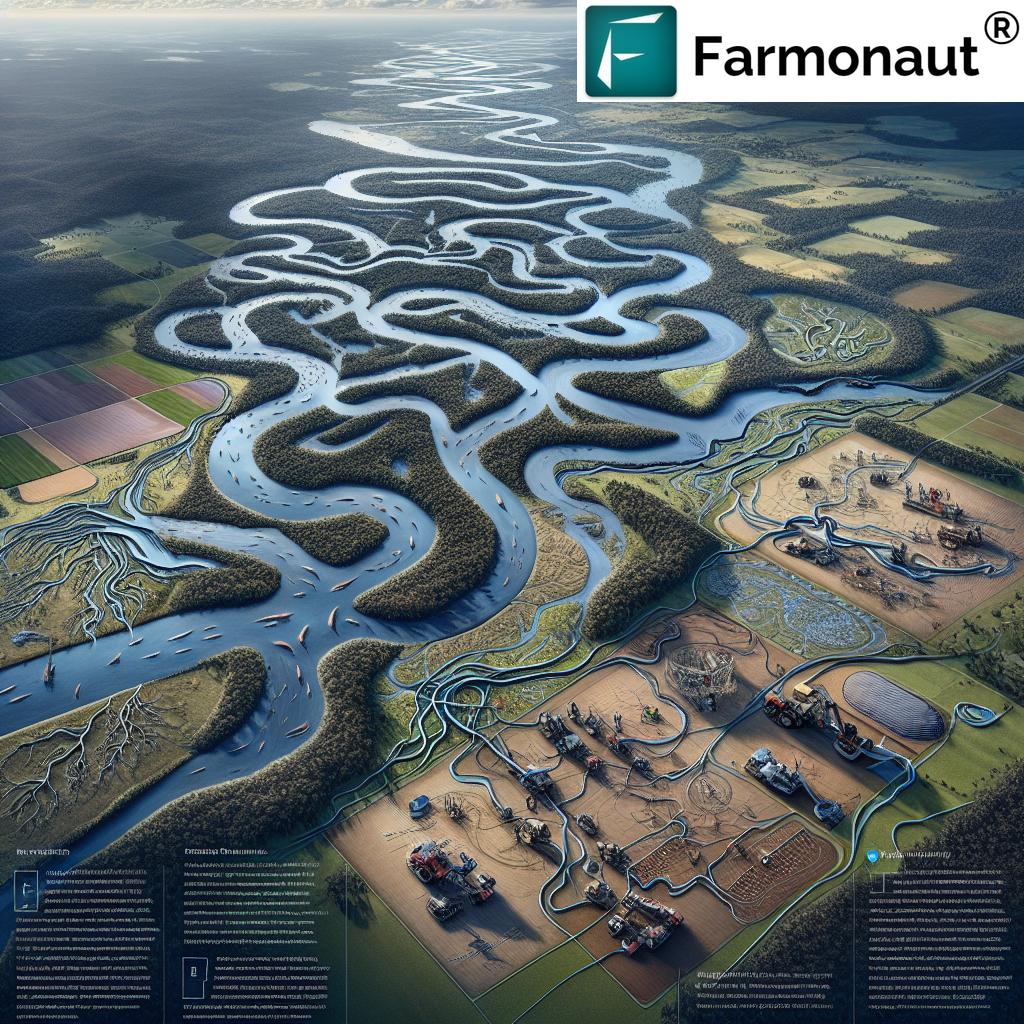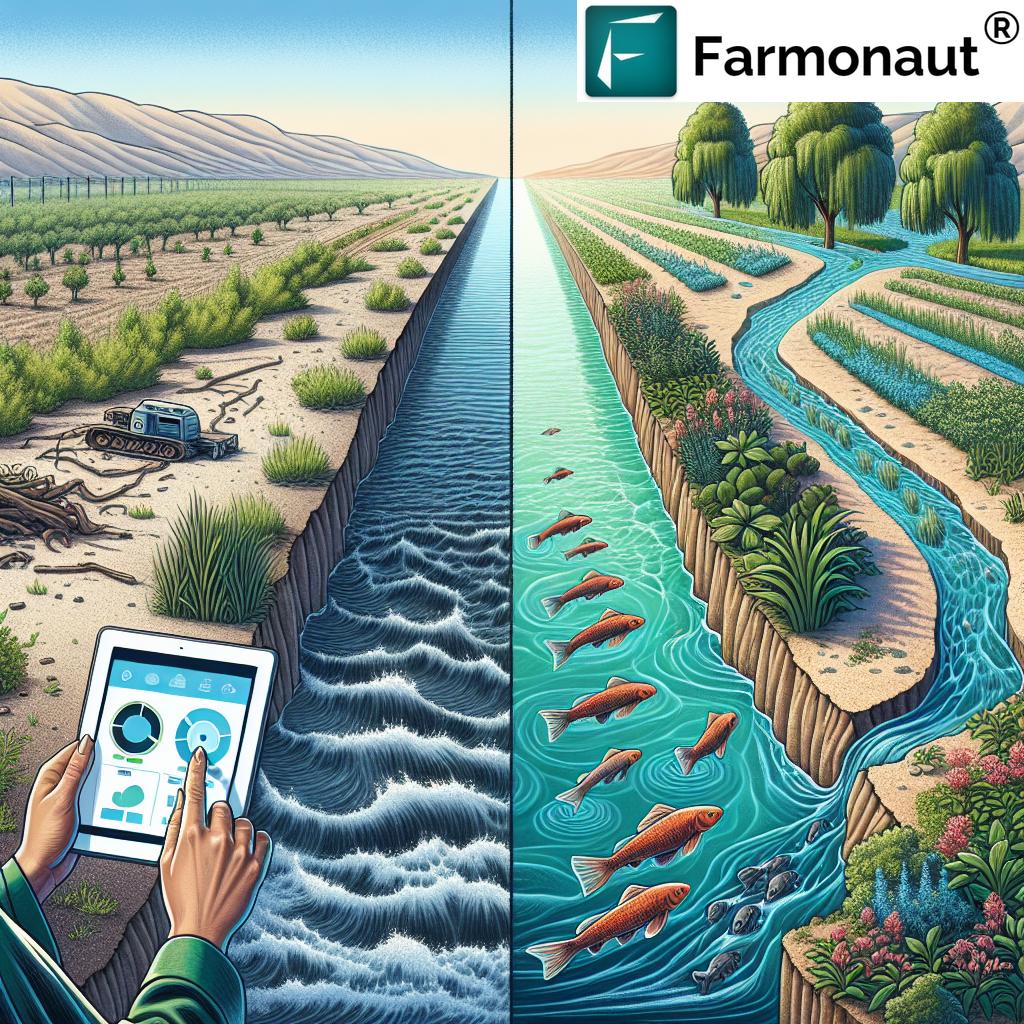Sustainable Aquatic Management: Farmonaut’s Guide to Northern Rivers Catchment Restoration and Fish Habitat Conservation

“The Northern Rivers catchment spans an impressive 50,000 square kilometers in NSW, Australia.”
Welcome to our comprehensive guide on sustainable aquatic management in the Northern Rivers catchment. As we delve into this crucial topic, we’ll explore the intricate balance between preserving our precious water resources and supporting the agricultural needs of the region. At Farmonaut, we’re committed to leveraging cutting-edge technology to promote sustainable farming practices that complement ecological conservation efforts.
Understanding the Northern Rivers Catchment
The Northern Rivers catchment is a vast and diverse ecosystem spanning 50,000 square kilometers in New South Wales (NSW), Australia. This expansive area is home to numerous rivers, estuaries, and freshwater habitats that play a vital role in maintaining the region’s rich biodiversity. From the mighty Clarence River to the smaller coastal streams, each waterway contributes to the ecological tapestry that makes this area so unique.
Key Features of the Northern Rivers Catchment:
- Diverse river systems
- Extensive estuarine habitats
- Rich aquatic biodiversity
- Critical importance for water resource management
As we navigate through this guide, we’ll explore how Farmonaut’s advanced agricultural technology supports conservation efforts by promoting efficient water use and sustainable farming practices. Our goal is to strike a balance between agricultural productivity and ecological preservation, ensuring the long-term health of this vital catchment area.
The Importance of Fish Habitat Conservation
Fish habitat conservation is a cornerstone of aquatic ecosystem health. In the Northern Rivers catchment, preserving and restoring fish habitats is crucial for maintaining biodiversity, supporting recreational and commercial fishing, and ensuring the overall health of the river systems.
Key Aspects of Fish Habitat Conservation:
- Protecting spawning grounds
- Maintaining water quality
- Ensuring fish passage through waterways
- Preserving riparian vegetation
At Farmonaut, we recognize the interconnectedness of agricultural practices and aquatic health. Our satellite-based crop monitoring system helps farmers optimize their water usage and reduce runoff, which in turn benefits the surrounding aquatic ecosystems.
Innovative Fish Habitat Restoration Techniques
Restoring fish habitats in the Northern Rivers catchment requires a multi-faceted approach. Here are some innovative techniques being employed in the region:
- Fish Passage Improvement: Removing or modifying barriers to allow fish to move freely through waterways.
- Riparian Zone Rehabilitation: Planting native vegetation along riverbanks to reduce erosion and provide habitat.
- In-Stream Habitat Enhancement: Adding structures like logs and rocks to create diverse habitats for fish.
- Water Quality Management: Implementing measures to reduce pollution and maintain optimal water conditions for aquatic life.
Farmonaut’s technology supports these efforts by helping farmers implement precision agriculture techniques that minimize the impact on nearby water bodies. Our satellite imagery and AI-driven insights enable farmers to make informed decisions about irrigation and fertilizer use, reducing the risk of harmful runoff.
Comprehensive Mapping of Estuaries
“Farmonaut’s guide covers comprehensive mapping of 154 estuaries in the Northern Rivers region.”
One of the most significant initiatives in the Northern Rivers catchment is the comprehensive mapping of 154 estuaries. This extensive project provides invaluable data for conservation efforts and sustainable management of these crucial ecosystems.
Benefits of Estuary Mapping:
- Identification of critical habitats
- Assessment of environmental health
- Monitoring of changes over time
- Informed decision-making for conservation strategies
Farmonaut’s satellite imagery technology complements these mapping efforts by providing regular updates on land use changes and vegetation health in areas surrounding estuaries. This information helps stakeholders identify potential impacts on estuarine environments and take proactive measures to protect these sensitive ecosystems.
Explore Farmonaut’s API for advanced satellite data integration
Challenges in Fish Passage Improvement
Improving fish passage throughout the Northern Rivers catchment is a complex undertaking that faces several challenges:
- Identifying and prioritizing barriers to fish movement
- Securing funding for infrastructure modifications
- Balancing fish passage needs with other water management objectives
- Addressing the impacts of climate change on water levels and flow regimes
To address these challenges, a collaborative approach involving government agencies, local communities, and technology providers like Farmonaut is essential. Our data-driven insights can help identify areas where agricultural practices may be impacting fish passage and suggest strategies for mitigation.
Success Stories: Local Pilot Projects
Across the Northern Rivers catchment, several pilot projects have demonstrated the potential for successful fish habitat restoration and conservation. These initiatives serve as valuable case studies for future efforts:
- Clarence River Fish Ladder: Installation of a fish ladder at a major weir, allowing native fish species to migrate upstream for breeding.
- Richmond River Riparian Restoration: A community-led project to replant native vegetation along degraded riverbanks, improving water quality and fish habitat.
- Tweed River Oyster Reef Restoration: Rebuilding oyster reefs to enhance water filtration and provide habitat for various aquatic species.
Farmonaut’s technology has played a role in supporting these projects by providing farmers in the surrounding areas with tools to optimize their water use and reduce agricultural runoff. This collaborative approach demonstrates how modern farming practices can coexist with and even support aquatic conservation efforts.
Balancing Agricultural Needs with Ecological Preservation
One of the greatest challenges in managing the Northern Rivers catchment is striking a balance between agricultural productivity and ecological preservation. This region is not only environmentally significant but also economically important for its agricultural output.
Strategies for Sustainable Agriculture in the Catchment:
- Implementing precision irrigation techniques
- Adopting soil conservation practices
- Using cover crops to reduce erosion and improve soil health
- Minimizing the use of agricultural chemicals
Farmonaut’s platform supports these strategies by providing farmers with real-time data on crop health, soil moisture, and weather conditions. This information enables farmers to make informed decisions that optimize resource use while minimizing environmental impact.

The Role of Technology in Aquatic Conservation
Advancements in technology are playing an increasingly important role in aquatic conservation efforts. From satellite imagery to AI-powered analytics, these tools are revolutionizing how we monitor and manage our water resources.
Technological Applications in Aquatic Conservation:
- Remote sensing for water quality monitoring
- GPS tracking of fish movements
- Automated water sampling and analysis
- Predictive modeling for ecosystem changes
Farmonaut’s satellite-based farm management solutions contribute to these efforts by providing valuable data on land use patterns and vegetation health in the catchment area. This information helps conservationists and resource managers make data-driven decisions to protect aquatic ecosystems.
Collaborative Initiatives with Landholders and Fishing Clubs
Successful aquatic management in the Northern Rivers catchment relies heavily on collaboration between various stakeholders. Landholders and fishing clubs play a crucial role in these efforts:
Key Collaborative Initiatives:
- Education programs on sustainable land management practices
- Volunteer-led river clean-up events
- Citizen science projects for monitoring fish populations
- Partnerships between farmers and conservation groups for riparian restoration
Farmonaut supports these initiatives by providing accessible technology that helps landholders implement sustainable farming practices. Our user-friendly platform enables farmers to easily monitor their land’s impact on nearby water resources and make adjustments as needed.
River System Health Indicators
Monitoring the health of river systems in the Northern Rivers catchment is essential for effective management and conservation. Several key indicators are used to assess the overall health of these aquatic ecosystems:
- Water Quality Parameters: Including dissolved oxygen, pH, temperature, and nutrient levels.
- Macroinvertebrate Diversity: The presence and abundance of aquatic insects and other small organisms.
- Fish Population Metrics: Species diversity, abundance, and age structure of fish communities.
- Riparian Vegetation Health: The condition and extent of plant life along riverbanks.
- Sediment Load: The amount of suspended particles in the water, which can impact habitat quality.
Farmonaut’s technology indirectly supports the monitoring of these indicators by helping farmers implement practices that reduce their impact on nearby water bodies. By minimizing erosion and runoff from agricultural lands, we contribute to improved water quality and overall river system health.
Freshwater Habitat Monitoring
Effective conservation of the Northern Rivers catchment requires ongoing monitoring of freshwater habitats. This monitoring helps identify trends, detect potential threats, and evaluate the success of conservation efforts.
Key Aspects of Freshwater Habitat Monitoring:
- Regular water quality testing
- Surveys of aquatic plant and animal species
- Assessment of physical habitat characteristics
- Monitoring of flow regimes and water levels
Farmonaut’s satellite imagery and data analytics capabilities complement these monitoring efforts by providing a broader perspective on land use changes and vegetation patterns in the catchment area. This information helps researchers and conservationists understand the complex interactions between terrestrial and aquatic ecosystems.
The Importance of Maintaining Aquatic Ecosystems for Future Generations
Preserving the health and biodiversity of the Northern Rivers catchment is not just a short-term goal; it’s a commitment to future generations. Healthy aquatic ecosystems provide numerous benefits:
- Sustainable fisheries for food security
- Natural water filtration and purification
- Flood mitigation and erosion control
- Recreational opportunities and tourism
- Cultural and spiritual significance for Indigenous communities
At Farmonaut, we believe that by promoting sustainable agricultural practices, we can help ensure that these vital ecosystems continue to thrive for years to come. Our technology empowers farmers to be stewards of both their land and the surrounding environment.
Access Farmonaut’s API Developer Docs for advanced integration options
Comparative Analysis of Northern Rivers Catchment Restoration Efforts
| Restoration Technique | Target Species | Estimated Area Covered (km²) | Potential Impact on Biodiversity | Implementation Challenges | Success Indicators | Technology Integration (Farmonaut’s Role) |
|---|---|---|---|---|---|---|
| Fish Passage Improvement | Migratory fish species | 500 | High | Infrastructure costs, regulatory approvals | Increased fish migration rates | Monitoring land use changes near passage sites |
| Estuarine Habitat Mapping | Various estuarine species | 1,000 | Medium | Data collection in remote areas | Comprehensive habitat database | Satellite imagery for large-scale mapping |
| Freshwater Habitat Monitoring | Freshwater fish and invertebrates | 2,000 | Medium | Continuous monitoring resources | Improved water quality metrics | AI-driven analysis of watershed health |
| Sustainable Farming Practices | Riparian and aquatic species | 10,000 | High | Farmer adoption, economic viability | Reduced agricultural runoff | Precision agriculture tools for efficient resource use |
FAQs
-
Q: How does Farmonaut contribute to aquatic conservation in the Northern Rivers catchment?
A: Farmonaut provides satellite-based farm management solutions that help farmers optimize water use and reduce runoff, indirectly supporting aquatic ecosystem health.
-
Q: What are the main challenges in fish habitat restoration in the region?
A: Key challenges include balancing agricultural needs with conservation, addressing climate change impacts, and securing funding for large-scale restoration projects.
-
Q: How can local communities get involved in catchment restoration efforts?
A: Communities can participate in volunteer clean-up events, citizen science projects, and educational programs about sustainable land management practices.
-
Q: What role does technology play in monitoring river system health?
A: Technology like satellite imagery, AI analytics, and remote sensing tools help in continuous monitoring of water quality, vegetation health, and land use changes in the catchment area.
-
Q: How does improving fish habitats benefit the broader ecosystem?
A: Healthy fish habitats support biodiversity, improve water quality, enhance recreational fishing opportunities, and contribute to the overall ecological balance of the catchment.
Conclusion
The Northern Rivers catchment is a vital ecological resource that requires careful management and conservation. Through innovative restoration techniques, collaborative efforts, and the integration of advanced technologies like those offered by Farmonaut, we can work towards a sustainable future for this unique aquatic ecosystem.
By balancing the needs of agriculture with environmental preservation, we can ensure that the Northern Rivers catchment continues to thrive, supporting both the local economy and the rich biodiversity of the region. As we move forward, the role of technology in supporting these conservation efforts will only grow, offering new opportunities for sustainable management and preservation of our precious water resources.






